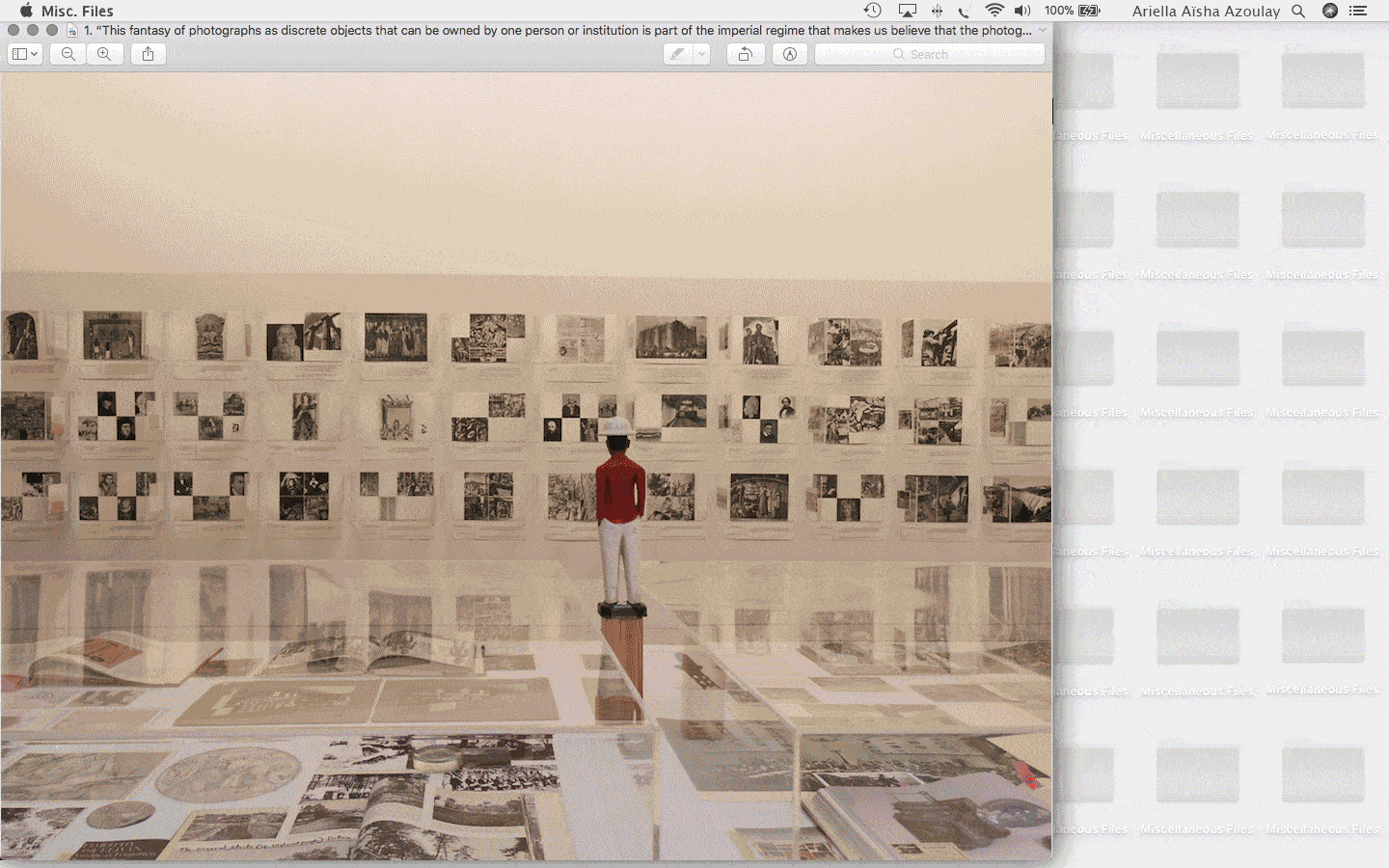Content warning: This interview contains descriptions of sexual assault.
It was only as an adult, when she read her father’s birth certificate, that the political theorist Ariella Aïsha Azoulay learned the name of her paternal grandmother—and the fact she was of Algerian descent. After that, Azoulay reclaimed the name her father had refused: Aïsha. “My father clearly did not want this name to circulate and be associated with our family, to taint the semi-white appearance he worked hard to acquire [in Israel],” Azoulay writes in her new book, Potential History: Unlearning Imperialism, She accuses her father of having “betrayed the ancestors,” condemning the logic of a man who had learned to conflate erasure with progress. This very logic convinced my own father that I didn’t need to know my grandfather’s name either, nor his reasons for migrating from India to Detroit in the early twentieth century. It was as if eliminating these significant details would eliminate his—my—difference.
Potential History is a project spanning centuries and nations, from the mass expulsion of Jews and Muslims from Spain in 1492 to Palestine today. It is a critique of and intervention in imperial knowledge production and the technologies that make it possible—museums, national archives, the discipline of history, the discourse of human rights, and the camera, which “made visible and acceptable imperial world destruction and legitimated the world’s construction on empire’s terms.” Azoulay, who, in addition to being an author, is a filmmaker and professor of modern culture and media at Brown University, expands upon a theory from her seminal book, Civil Imagination: A Political Ontology of Photography, by positioning the roots of photography in extraction and erasure. With Potential History, Azoulay aims “to make non-imperial sense out of existing knowledge that imperialism has manipulated and relegated to different domains.” This includes reimagining everything from timelines to political sovereignty to interpretations of individual photographs.
Of course, this work is not for the imagination alone. Azoulay, who disavows her Israeli citizenship, calls for open borders and the fundamental right to migration. She argues that people whose worlds have been destroyed by centuries of imperialism have the right to live near the objects that have been plundered from their culture and now sit in the “neutralizing” space of Western-style museums. In fact, she suggests, those objects might constitute the very “documentation” the countries hosting those museums demand of migrants.
I talked with Azoulay over Google Chat while she was in Berlin and I was in Brooklyn. She prefaced our discussion by saying that she tries to think and communicate in non-imperial terms. I understood this as an invitation to allow language to take unexpected turns. What followed was a dense, rich, daunting, and hopeful discussion about the (im)possibilities of decolonization, the potential of gallery spaces, and the invisible work of research. Central to Azoulay’s process—whether creating the contents of a book, a gallery exhibition, or a film—is refusing the role of the scholar who, as the expert, assigns meaning and “discovers” new knowledge. In practice, this involves tracing, cropping, cutting, juxtaposing, annotating, and erasing the texts from history’s totalizing narratives. Yet her process is even richer than that: Potential History is not only about the past, but about the enormous possibilities of the present.
–Sabrina Alli
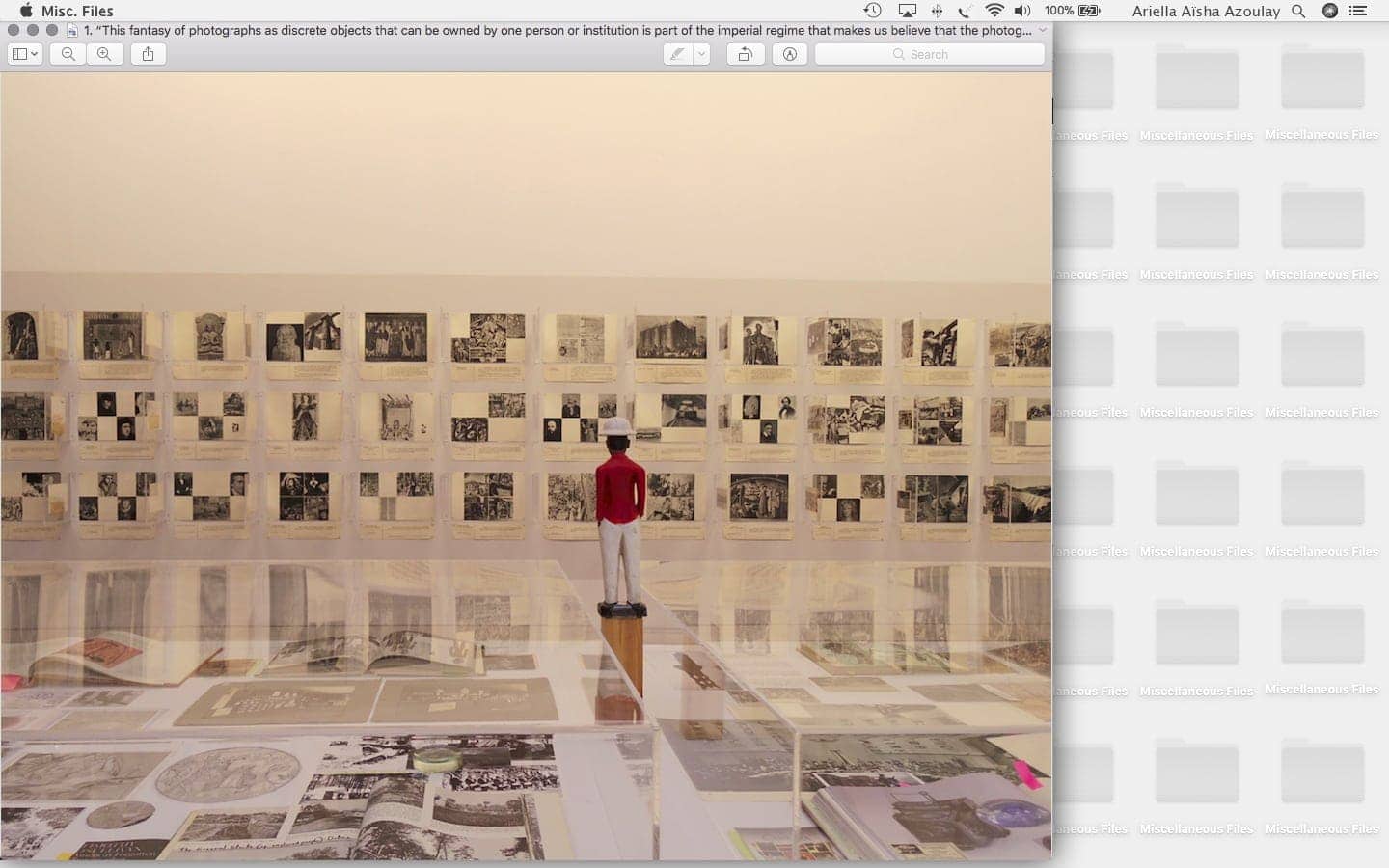
1. “This fantasy of photographs as discrete objects that can be owned by one person or institution is part of the imperial regime that makes us believe that the photograph captures a bygone moment to which we are the latecomers.”
Sabrina Alli: I’d like to start with photography. You write, “photographs should not be thought of as raw archaic material, primary sources, or positive facts whose intrinsic meaning is to be spelled out through research.” So what do you think photographs are?
Ariella Aïsha Azoulay: Photography was invented as an imperial practice and it was thus a productive practice—geared toward the production of images, and, in a broader sense, commodities. This valorized photography’s products, meaning photographs, and enabled the undisputed use of others’ free labor—those being photographed—as raw material.
In a non-imperial understanding of photography, the photograph is only one possible outcome of a complex encounter. The encounter involves not only the one who holds the camera and those in front of it, but also other participants, including imaginary spectators. These spectators are not necessarily the same from the point of view of the photographed person as they are from that of the photographer. While the person who holds the camera is most likely committed to a milieu of experts—an editor, for example, in the different venues where the photograph is likely to be published, and an audience—the person who is photographed has perceptions and aspirations of her own. We should not let the photograph, a contingent product, overshadow the complex nature of the encounter out of which it was taken, nor to blur the inequalities, the patterns of exploitation, and the incommensurable expectations, aspirations, and modalities of participation inherent in a photographic event.
When we understand photographs not only as the focal point or end product of photography as a practice, we face both its imperial and non-imperial potential. It also makes it easier to see how we can be manipulated to naturalize photography’s imperial nature; that is, easily inhabiting the scripted roles offered to us as scholars, curators, photographers, and spectators. This fantasy of photographs as discrete objects that can be owned by one person or institution is part of the imperial regime that makes us believe that the photograph captures a bygone moment to which we are the latecomers. This teaches us imperial notions of time and separates shared encounters into the property of an individual.
Photography was built on already existing imperial practices, structures, and regimes that it continues to reproduce. Relating to photography as if it has a separate history originating with the invention of the device in the nineteenth century means ignoring the way photography accelerated and enhanced the process of primitive accumulation of wealth (especially visual wealth), labor, and resources from people in Africa, India, and the Middle East. Without this primitive accumulation of photographic wealth, the majority of Western-type museums and archives could not exist. Scholars are trained to see archives and museums as benign sites of research where they can find their objects, forgetting that they themselves take part in the conflation of violence and scholarship. In the book, I reject the centrality of the camera in the story of photography’s invention and foreground instead “the infrastructure of extractions”: that is, what enabled the camera’s access to people as free raw material for the production of photographs, which then became “primary sources” for other experts to consult and interpret. My book questions the naturalization of this category of “sources” (“primary” or “secondary”) and reconstructs the production, accumulation, and naturalization of the photographic “raw material” under imperial power. What is free raw material, to whom is it free, and what do we forget?
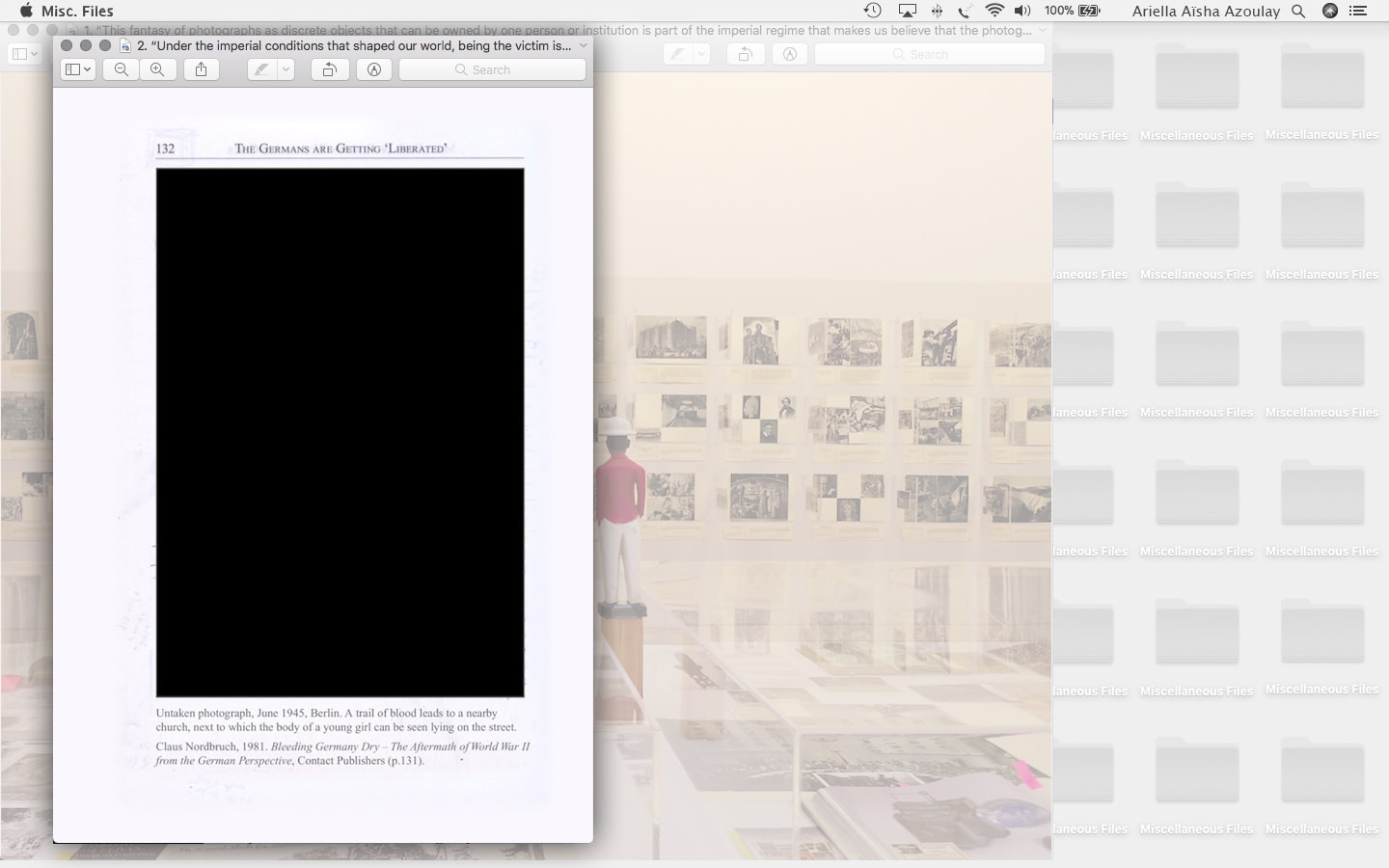
2. “Under the imperial conditions that shaped our world, being the victim is not only the outcome of violence, it is also ‘a right’ that can be given and taken.”
Alli: I was struck by a part of the book where you arrive at this analysis about photographs that show the event well known as the Holocaust. What I took away from your analysis is that we, the viewers, don’t assign meaning to photographs, they’re given to us. There are photos that we all recognize as depicting the Holocaust—which have become iconic, and make it seem exceptional compared to other atrocities.
Azoulay: The identification of the term “Holocaust” with the extermination of the Jews overshadows the multiple groups targeted by the Nazi extermination plans. This enables the exceptionalization of the extermination of the Jews alongside the exceptionalization of the Nazi extermination plans, thus normalizing centuries of genocide of different peoples.
Those photographs of piles of corpses taken in liberated camps are associated with the extermination of Jewish people, but actually we have no way of knowing whose bodies these are, since different groups were incarcerated and exterminated. They could be African soldiers from the colonies who were taken as prisoners of wars and sent to the camps, they could be Communists, Jews, or Roma people. This helps create a regime of differential sensitivity to violence, predicated on who is targeted, by whom, and under which circumstances.
Under this regime, being born an “Israeli Jew”—a violent category toward non-Jews and non-white Jews alike—means recognizing the exceptionality of the violence toward Ashkenazi Jews as the primary definition of violence. It also relates the violence perpetrated by those identified as “Israeli Jews” as a simple policy, one that is tolerable or perhaps not even “violent” at all. In my book, I describe my rejection of the adjective “Israeli” as part of my identity, acknowledging that the name of “Israel” legitimates a campaign of violence that omits the destruction of Palestine. Writing this book is part of righting this wrong. I refuse to be enlisted in ontological violence. I insist on actualizing other lineages that the state renders unimaginable, such as me being an Arab Jew and a Palestinian Jew of African origins.
This takes us to this image. My project of inscribing the rape of German women in the photographic imaginary of World War II originated in a similar refusal. Among the thousands of photographs taken during what is known as the end of World War II, there is not a single photograph associated with the rape of between one and two million German women. Rather than going to the archive and searching for the photographs of these acts, I reviewed the existing corpus of photographs. Based on the assumption that many of them were taken at the same sites where rape occurred—one to two million rapes, largely in one city, so consider the dense geographic occurrence of rape—I asked myself which of them required an extra epistemological manipulation in order to dissociate it from the mass rape of women. The question was how to reject the status of mass rape as incidental to the major events of the war and the foundations of democratic political theory, and show its important role in the imposition of “the new world order.”
Prior to my study of the rape of German women, I studied the rape of Palestinian women by Jewish soldiers and its role in the establishment of a racial patriarchy in Israel. Other scholars studied the rape of women during the partition of India and Pakistan, and that of enslaved Africans and African Americans. When these rapes are considered together, it is hard not to see that without the violence of rape, democracy could not gain its status as the only viable political regime. That is, the mass rape of women is both central to western democracy and has been occluded by it.
With these series of “untaken photographs of rape” I impose on the archive a different kind of photograph—what I call the “untaken photograph.” I took sentences about the rape of German women in 1945 from books and transformed them into captions. I printed these captions below blank squares in different sizes, figured as placeholders in the archive, challenging the way the imperial archive operates through absences and silences. If we are seduced by this trap of “the archive’s silence” we can find ourselves seeking the documents it has the power to conceal from us. Producing these placeholders is a way to switch from the position of passive clients of what is in the archive to the active position of rejecting its authority to define what exists and what does not. It is worth emphasizing that these placeholders do not mark unknown events; they deliberately mark events we know happened, but which the archive orchestrates as non-events because of the lack of documents, as if documents are needed to prove a large scale campaign of violence.
The mass rape of German women by Allied Forces in occupied Berlin after 1945 was conducted with the justification that Germans had to “pay the price.” When some German women started to talk about this rape, they were silenced under the pretext that they could not, as citizens of Germany’s overthrown Nazi regime, inhabit the position of the victim. Under the imperial condition that shaped our world, being the victim is not only the outcome of violence, it is also “a right” that can be given and taken. Being born a Jewish woman, I felt compelled to use my position as a Jew against the way this history was scripted to justify that violence. As a scholar of photography, I sought to inscribe this rape in the same imaginary of violence from which it was removed, and to place it alongside other types of violence, refusing the script given to us about victims and perpetrators.
Alli: I am trying to understand the relationship we have to photography and its limitations. Do we have the right to see everything? What is role of photography in helping to create a culture of memory?
Azoulay: We certainly do not have the right to see everything, but this cannot be defined by the state or by experts. The practice of non-imperial potential history, as I describe in my book, engages with how different communities can restore the limits they impose on this imperial right, without aspiring to come up with some universal ethics of the gaze. There is a very recent example concerning the publication last year of the coffee table book Sex, Race, Colonies, edited by French historian Pascal Blanchard. This man acted like a neutral historian who had “discovered” a collection of postcards from the French colonies and whose professional duty was to bring them to the awareness of the public. These are postcards that show different degrees of sexual violence, and that circulated among the French across their empire. The images are certainly not his discovery, and such a collection cannot be published as is under the mantra of “education.”
It is academic audacity, born of imperial ways of knowing, that enables a historian to act as if it doesn’t matter that victims and their descendants know what was done to them; it doesn’t count as “known” unless it is articulated in academic language by a credible expert. Historians who “discover” imperial violence from the archive often seek to share it with their peers, who enjoy similar privileges of access to documents of violence for the purposes of academic “discovery” rather than for the purpose of halting the violence inscribed in them.
For a white male French historian, postcards that were taken in the nineteenth century are historical objects. For racialized women in the former French empire, this is not a bygone past, as members of the French collective Cases Rebelles wrote in a brilliant manifesto, The Exhausted Bodies of the Colonial Spectacle (Les corps épuisés du spectacle colonial), against the publication of the book. When imperial violence is not brought to an end through the transformation of the infrastructure that enables it, such violence will be a continuous reality. So rather than seeking some universal rules drafted by experts, local communities should have the right to set rules about who has the right to see and to show, what is known and unknown about imperial violence, and how it could be repaired.
The idea of the book, of working in this 500-year temporal framework from 1492 onward, is to foreground the amount of imperial violence that was and is required to destroy different cultures and enable the imperial fantasy of universality to exist. The allegedly universal ethical code about looking at pain and death doesn’t make sense when we broaden the scope out to 1492. It is not about whether future corpses should be shown or not; what do you do with all the corpses that have already been shown, let alone produced? Reminding ourselves that billions of people have been killed by imperial actors in the last 500 years is also a reminder that there is nothing progressive about the idea of not showing bodies.

3. “This object, like millions of others, was part of the fabric of life, not part of the monoculture we now call ‘museum.’”
Alli: The imperial idea of temporality claims that there are discrete units of time. There is the past, which is over, and there are the present and the future. In your work, you break with the borders that imperialism requires, both spatially and in temporality, but also within institutions like archives and museums. Looking at this photograph, can you say more about your understanding of the relationship between plundered objects in a museum and the neutralizing function that museums serve within society?
Azoulay: I took this image last year at the Royal Museum of Central Africa in Tervuren, Belgium. This museum was founded by King Léopold II to display objects stolen from the Congo, access to which other imperial actors had “granted” him with imperial hubris and power. King Léopold II, responsible for the genocide of millions of Congolese, built this museum with the resources, free labor, and treasures that he plundered from Congo. Seven years ago the museum announced that it was starting a process of decolonization and closed its doors until reopening last year. I’m afraid, though, that the museum’s understanding of decolonization is very limited.
In the 1950s, when Congo was still under Belgian occupation, this object stood at the top of a chief’s house. I saw it first in a small booklet of images taken by a Belgian art historian. What does it mean to be a Belgian art historian who publishes research in state publications when the objects you study are stolen and the people to whom they belong are under occupation? It means that you have free access to everything expropriated from these people and the imperial right to see everything. This right is recognized by one’s imperial peers, but refuted by the people to whom the objects belong.
Even though they had been colonized, people sought ways not to let experts see everything. Their resistance was often repressed by armed forces, but ignored by non-armed experts of empire, meaning scholars. The image of this object taken in the 1950s encapsulates this. The Belgian art historian who took the photograph wrote in the caption that the left arm was deliberately broken by the local people who didn’t want to be forced to disclose its meaning or hand over the power of the object. Even though the art historian understood the message, he nonetheless took a photograph of the object, which was then transferred to the museum and is still being shown there, with no account of the violence that facilitated its transfer. Now displayed in the museum, there is no caption attesting to this resistance, and the object, actually crafted in the mid-twentieth century, is displayed as an old tribal piece, a ruin of a sort.
The local people were prepared to damage their own beloved object to protect their culture from the invading gaze of the colonialists. What we do not know is if the elimination of this piece increased or decreased the amount of violence exercised against them to force further disclosure of their secrets in the name of scholarship and “universal” values of art, knowledge, and historic preservation. This object, like millions of others, was part of the fabric of life, not part of the monoculture we now call “museum.” When we speak about the plunder of objects, the violence is not only that of extraction, it is also the violence of naturalization: that is, of what was extracted by the museum so that museum-goers can look at the objects as detached from the physical, spiritual, and cultural environment of which they were part and from the decades of violence that severed them from that environment.
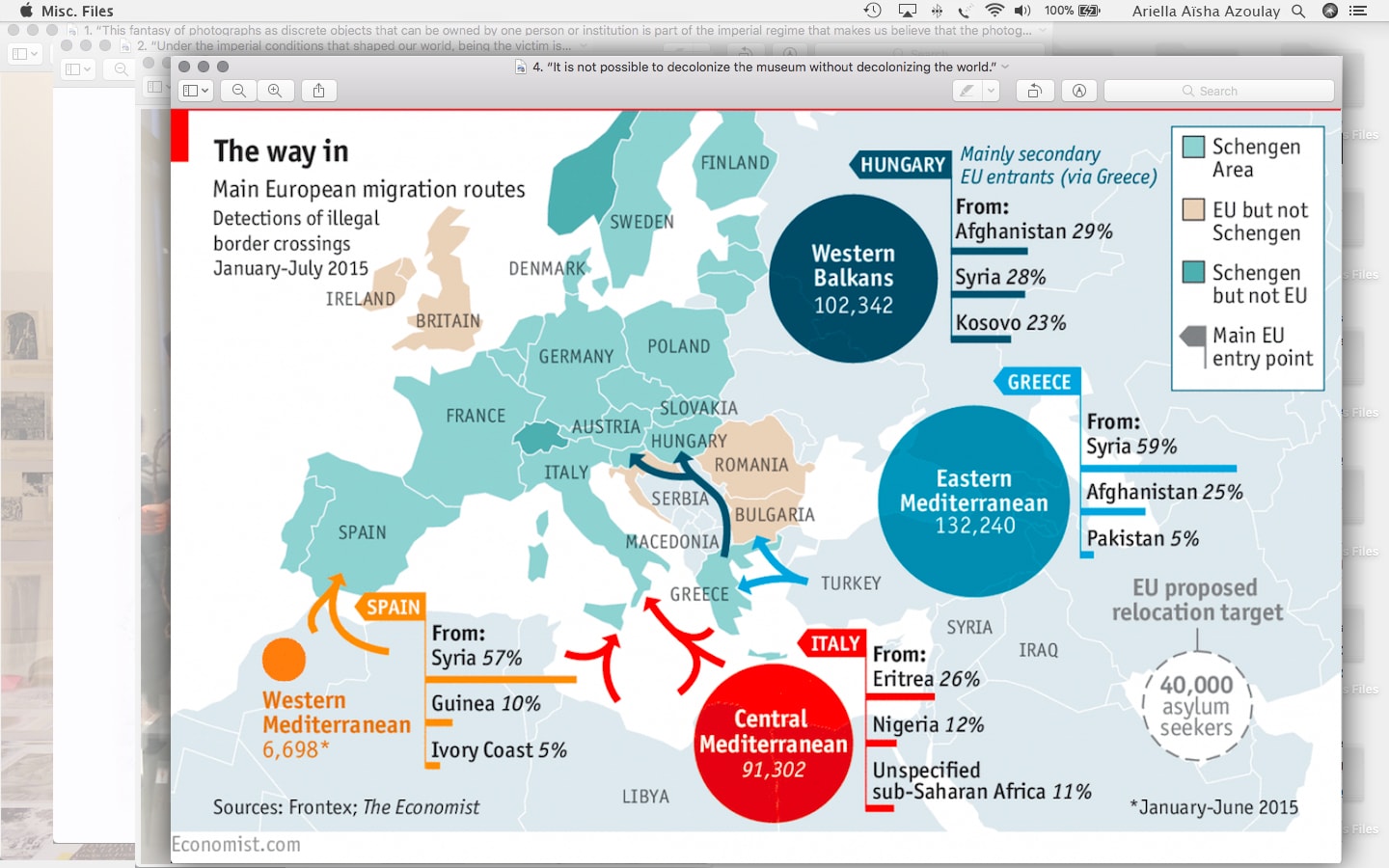
4. “It is not possible to decolonize the museum without decolonizing the world.”
Alli: So, is it even possible to decolonize a museum, or decolonize an archive? Your work sits within a movement calling for decolonization, along with the work that Decolonize This Place is doing.
Azoulay: It is not possible to decolonize the museum without decolonizing the world. It doesn’t mean that we shouldn’t engage with this important work, but we have to do so with the full awareness that decolonization cannot be limited to discrete objects, museums, or archives, and cannot be substantial as long as the people from whom all this wealth was expropriated are not allowed to lead the process. It is not about hiring an individual curator from Congo or Nigeria, but about opening the imperial borders and letting people re-build their worlds in proximity to their objects.
When I look at this map of migration, I see patterns of counter-expeditions, a belated movement of people to join the objects that were forcibly migrated away from them decades or centuries earlier. We should think about those people who are deemed “undocumented” alongside this massive forced migration of objects that started in the sixteenth and seventeenth centuries, objects that are still held in imperial archives, museums, and libraries.
Rather than thinking of decolonizing the museum as a discrete institution, as if the museum exists in a world apart, I study the correlation between the migration of people and objects, out of which I configured this non-imperial right—the right to live near your objects. With this right, it is not hard to imagine what it would mean to live in a world free of imperial borders, a world in which people whose culture had been destroyed are recognized as those whose rights are inscribed in the objects preserved in Western-type museums.
Rather than calling these people “undocumented,” I offer a shift that enables us to see their “documentation”—that is, their rights—in their objects. The statue with the broken arm holds within it the rights of the Congolese to use the resources of the Belgian state to repair their world. Rather than viewing these people as object-less or place-less, we should recognize their worldliness in their objects, now violently held in museums, and call on these objects to advocate for their rights.
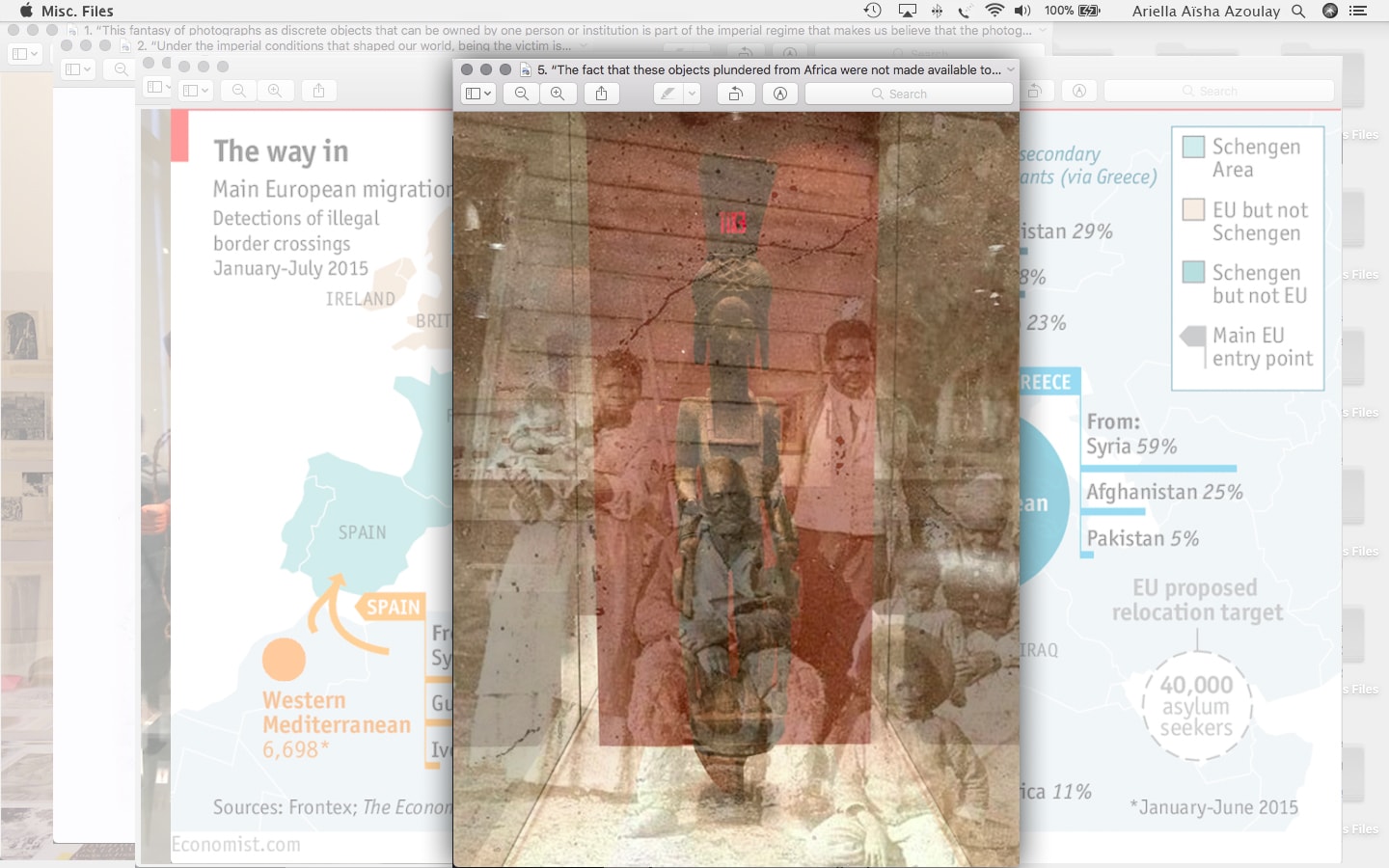
5. “The fact that these objects plundered from Africa were not made available to African Americans is the ultimate proof that decolonization of museums cannot be pursued outside a wider process of decolonization.”
Azoulay: We can continue this conversation by considering another image, actually a superimposition of two photographs, one of which was taken by Timothy O’Sullivan. Captions often indicate that this is a photograph of five generations of slaves at J.J. Smith plantation, a statement that is not neutral. At the moment the photograph was taken, these people were no longer slaves nor was this place still J.J. Smith’s plantation (if it ever was, as the plantation is a complex of stolen land, stolen property, and stolen labor). At that moment, at the ending of the Civil War, J.J. Smith had already run away, and the enslaved people had freed themselves as part of what W.E.B. Du Bois called the “general strike of the enslaved.”
I produced two such juxtapositions that I call “dismissed reunion,” which consist of two types of images. One depicts freed African Americans, and the other shows objects looted from Africa and held in museums, as if they have nothing to do with these property-less formerly enslaved people.
The fact that those millions of objects from Africa were not reunited with people who were kidnapped from Africa is the ultimate sign of America’s unwillingness to abolish slavery and to enable African Americans, whose culture was plundered, to reclaim it as part of recovering from the trauma. These objects continue to be the cultural assets of white culture, studied and handled mainly by white experts who protect the imperial license of museums to own them instead of being owned by the descendants of their makers. The fact that these objects plundered from Africa were not made available to African Americans is the ultimate proof that decolonization of museums cannot be pursued outside a wider process of decolonization. Through the activity of Decolonize This Place, which is targeting museums such as New York City’s Natural History Museum, sites of gentrification, museum trustees, corporate power, and rising subway fares, we can see the beginnings of what a full decolonization could look like.
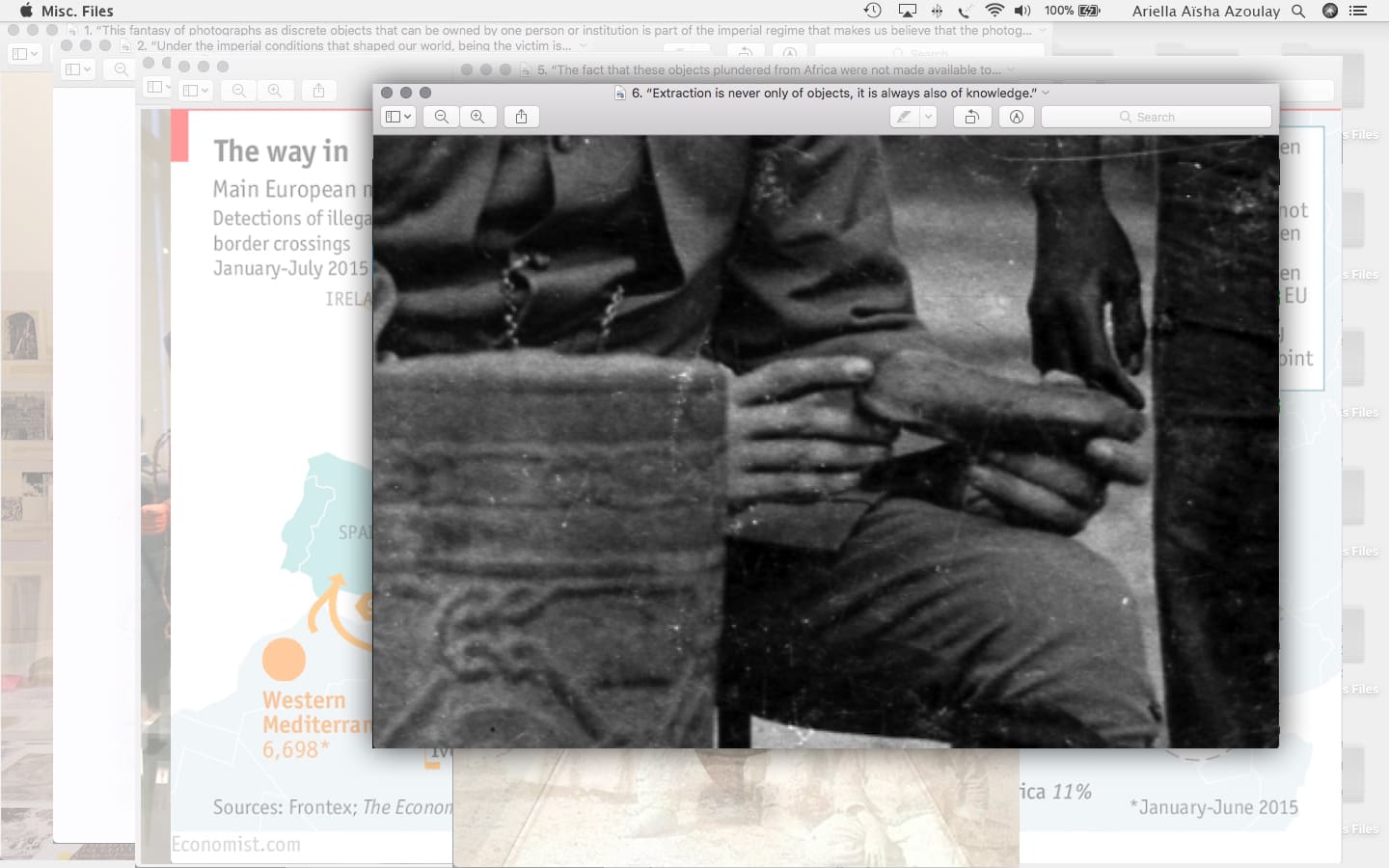
6. “Extraction is never only of objects, it is always also of knowledge.”
Alli: The picture of the hands. What is this image?
Azoulay: I produced a series of cropped images like this one, foregrounding the extraction of objects. I’m interested in the gestures involved in the practice of expropriation and the transfer of these objects to museums. My assumption is that as scholars, artists, photographers, and curators, we have inherited these gestures, and we have to recognize them in our bodies in order to unlearn them. Rather than engaging with such photographs as documents that, as a scholar, I’m expected to study and interpret, I approach photographs with pens, scissors, and tape in order to break the spell of the photographic document.
The original caption describes a collector specializing in African art. For me, he is not a collector, nor an ethnographer, but an actor in an orchestrated campaign of plunder. Rather than studying him in comparison to other collectors and affirming the collector as a neutral category, I’m looking at the materiality of the act of extraction. This what guides me when I decide how to crop the image. The one who extracts holds the object in his hand—in a way common to curators or other experts who manifest, through this gesture, the embodiment of their knowledge. But there is another hand nearby, a non-white one. This is the hand of the person from whom information is being extracted and used to empower the experts and enrich the institutions for which he works. Extraction is never only about objects, it is also extraction of knowledge. Without the informants, those would-be-experts could not be experts, since the objects would be kept opaque to them. It is worth mentioning that during the initial process of extraction, these informants were exploited—their labor was assumed to be free to take. Once the information was extracted, many of them were compelled to be porters for the white scholar-experts, expected to carry tons of these objects to the ports to be shipped away. In this cropped image, you can see one example of how experts became authoritative figures from whom generations of students learned about other people’s cultures.
We started our conversation with my struggle to unlearn the right of the nation-state to become the adjective that defines me: “an Israeli.” This struggle cannot be detached from the one against the imperial premises of scholarship, the refusal to let institutions define what I see or expect to see, what I can say and what I’m not allowed to say. Both citizenship and scholarship come with a set of privileges that should be unlearned. Going on strike against the archive is one way to do so.
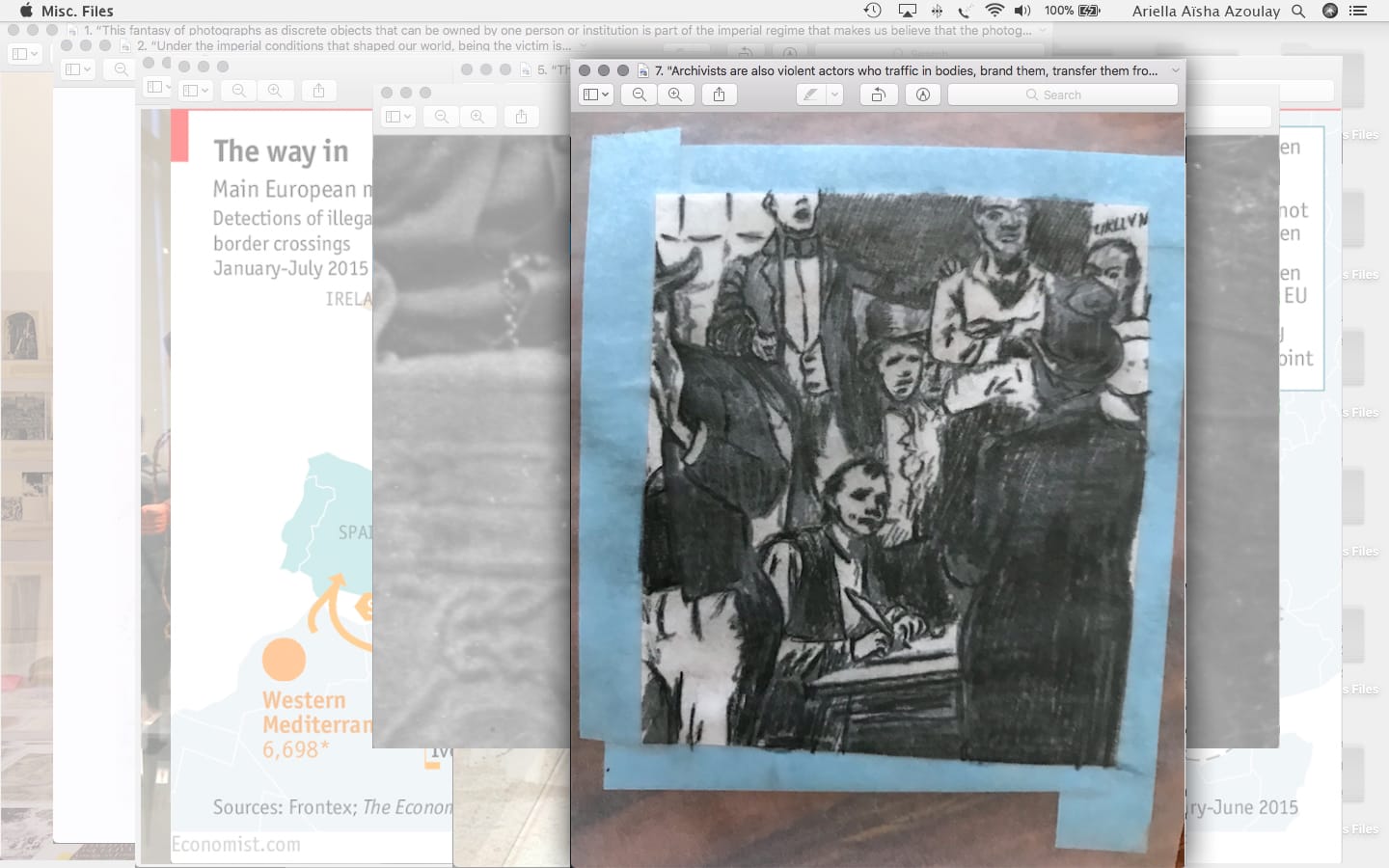
7. “Archivists are also violent actors who traffic in bodies, brand them, transfer them from one place to another, put them under chain and lock.”
Azoulay: To fight the ideology of the distant gaze, I’m experimenting a lot with images. Here, for example, is a series of drawings that I traced as a way to bypass the regime of copyrights. It is another cropped image. I focus on this man who sits near a big book in which he writes information regarding the trafficking in African bodies. We don’t know exactly what he writes, but he is part of the culture of lethal documents that proffer verdicts of enslavement to people who have been kidnapped. I am interested in the presence of documents at the moment when physical violence is exercised and how the documents are used to tame the horror. Tracing these images, cropping them, detaching them from the institutional authority under which their meaning is defined, is part of an attempt to undermine the assumption that the archive is a deposit of primary—and hence sacred—documents. These documents of violence are themselves violent: They partake in the transformation of people into slaves. I am trying to create a different imaginary of the persona of the archivist. Our conception of the archivist is of a tedious ant at the service of scholarship, but archivists are also violent actors who traffic in bodies, brand them, transfer them from one place to another, put them under chain and lock.
Alli: You drew that?
Azoulay: Yes. But not as an artist would draw an image. I sometimes draw them, other times I crop or tape them. One of these drawings is central to the book. It is the “Unshowable Photograph” of my Palestinian companion. I first encountered his photograph at the International Red Cross Archive, I think in 2009. The archive didn’t allow me to show the image in an exhibition I was curating. I was asked to sign a document consenting to show this and other images from the CIRC Archive with their original captions only. The meaning of my term “Unshowable Photograph,” then, is not that the image cannot be seen but rather that it cannot be shown by me. The archive acts as the proprietor of the images of which it is only the guardian, and purports to decide how those images will be shown, by whom, and to whom. You can go to the archive and see this image—the point is that you won’t see it as I would show it to you. This is what I refuse when I draw the image: the right of the archive to preserve the terms under which violence will be shown and studied. The caption, in this case, obscuring the destruction of Palestine and normalizing the creation of Israel, is crucial. It replaces one order with another, to make people believe that Palestine is gone and Israel took its place.

8. “I never just read a book; I annotate it, I write against its arguments, I juxtapose it with images and objects, I erase what is written in it.”
Azoulay: This is an image of one of twelve tables on which I spread the project Errata [an exhibition at Fundació Antoni Tàpies that Azoulay co-curated with Carles Guerra]. It consists of interventions in approximately sixty books. I never just read a book; I annotate it, I write against its arguments, I juxtapose it with images and objects, I erase what is written in it. This kind of work is usually invisible, part of the process called research, out of which a coherent paper can be published in an academic journal. In Errata, I push this behind-the-scenes work to the foreground. Using tape to erase or emphasize elements is not about aesthetics, but about what should not be kept as is. For example, in this book titled “Promised Land” I could barely leave one sentence intact. In others, I cannot let the separation between objects and people persist.
Alli: It’s interesting to talk about the potential of spaces. How do you approach the space of a gallery? What are you trying to do differently with gallery space?
Azoulay: The gallery for me is an opportunity to engage with different items—images, objects, or texts —to have the physical items interact with people in a shared space, rather than withholding the items from the public and granting limited access to the “outcome” through the format of a publication. When I unfold such archives in a gallery space, I try to spend as much time as possible in the gallery to generate this type of conversation with people.
I am not an artist, and I am not trying to produce things that will have value in or from the art world. It is simply that I do not think only with texts; objects and images are part of my world, and I learn with and through them no less than through textual sources. Imperialism reproduces itself through a series of curatorial practices, and developing different approaches is part of my commitment to unlearning imperialism.

